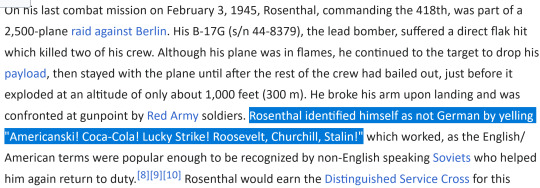#World War II History
Explore tagged Tumblr posts
Text

Gen. George S. Patton
#history#vintage#photography#portrait#black and white photography#george patton#george s patton#general#army#american army#u.s. army#us army#army histiry#veteran#us history#u.s. history#american history#20th century history#20th century#twentieth centrury#twentieth century history#world war ii#world war two#world war two history#world war ii history#war#war history
28 notes
·
View notes
Text
Ted Coldwater's airplanes
This might not matter to anyone but me (art purposes), but I'm identifying some of Quentin's father's model planes. The one in the foreground left here is a P-47 Thunderbolt, one of the workhorses of World War II, flown by the U.S. Army Air Forces. This one flew with the 56th Fighter Group, 61st Fighter Squadron, 8th Air Force (stationed at the RAF air bases in this order: RAF Kings Cliffe, then moved to RAF Horsham St Faith, then RAF Halesworth, and finally RAF Boxted--most likely flying out of Boxted). I can't see the serial number on the tail, so I can't be certain, but one of the most popular model planes of this type is the P-47D (serial number 42-26418) flown by Lt. Col. Francis "Gabby" Gabreski out of Boxted. If you have more info, please let me know.
By the way--Quentin's mom was wrong on so many levels. So many. Including the fact that these planes aren't a worthless waste of time, or something to quickly dispose of--not just for sentimental reasons. Q's dad's collection would indeed have been worth quite a lot. Most of all I wish Q had been able to keep at least one plane to remember his dad--no matter how much catharsis Jennifer helped him achieve that day.

#the magicians#quentin coldwater#ted coldwater#model airplanes#world war ii history#world war ii planes#p 47 thunderbolt#wcbac
12 notes
·
View notes
Text
Remembering those that died at Pearl Harbor today.
Many people know the beginning or abbreviated version of Roosevelt's speech delivered to Congress on December 8, 1941. Have you ever heard or seen the whole speech?
Transcript: https://time.com/4593483/pearl-harbor-franklin-roosevelt-infamy-speech-attack/
Recording:
https://youtu.be/YhtuMrMVJDk?si=4ioNrT-9Ufv9DzrD
3 notes
·
View notes
Text
Singapore's History and Heritage: A Walk Through Time

Nestled at the crossroads of Southeast Asia, Singapore is a city-state with a rich tapestry of history and cultural heritage that dates back centuries. From its humble beginnings as a fishing village to becoming a global economic powerhouse, Singapore has undergone a remarkable transformation. Today, the city-state stands as a testament to the harmonious coexistence of tradition and modernity. While exploring the key milestones that have shaped Singapore's history and heritage, visitors can also indulge in various things to do in Pai and experience the vibrant scene of shopping in Thailand.
Early Days: A Fishing Village to a Trading Hub

Singapore's story begins in the 14th century when it was a mere fishing village known as Temasek. It wasn't until the arrival of Sang Nila Utama, a Sumatran prince, in the 13th century that the island gained prominence. The prince renamed the island "Singapura," which means "Lion City" in Sanskrit after he allegedly spotted a lion on its shores. Although lions never roamed the island, the name stuck, symbolizing strength and courage.
In the 19th century, Singapore's strategic location at the crossroads of major shipping routes attracted the attention of European powers. Sir Stamford Raffles, the founder of modern Singapore, established a British trading post in 1819. This marked the beginning of Singapore's rapid ascent as a crucial trading hub in the region.
Colonial Era and World War II:

Under British colonial rule, Singapore flourished economically, becoming a melting pot of cultures due to its strategic location and open trade policies. However, the prosperity was interrupted during World War II when the Japanese occupied Singapore from 1942 to 1945. The war left an indelible mark on the island, with the Battle of Singapore being a pivotal moment in its history. After the war, Singapore went through a period of recovery and reconstruction.
Independence and Nation-Building:
The desire for self-governance gained momentum in the post-war era, leading to the formation of the People's Action Party (PAP) in 1954. Led by Lee Kuan Yew, the PAP advocated for independence from British rule and social reforms. Singapore achieved self-governance in 1959 and joined the Federation of Malaysia in 1963. However, the union was short-lived, and Singapore gained full independence on August 9, 1965, due to political differences with Malaysia.
Lee Kuan Yew became the first Prime Minister of Singapore and embarked on a nation-building journey characterized by economic development, social cohesion, and multiracial harmony. The transformation was remarkable, turning Singapore from a developing nation into a first-world city-state within a single generation.
Cultural Diversity: Harmony in Diversity

One of the defining features of Singapore is its multicultural society. The island is a mosaic of different ethnicities, including Chinese, Malay, Indian, and various other communities. This diversity is not only evident in the population but also in the architecture, cuisine, and traditions that permeate the city.
Chinatown, Little India, and Kampong Glam are iconic districts that showcase the cultural richness of their respective communities. Visitors can explore the vibrant markets, temples, mosques, and churches, experiencing firsthand the harmonious coexistence of different faiths and traditions. The annual celebrations of festivals such as Chinese New Year, Deepavali, Hari Raya Puasa, and Christmas further highlight the multicultural tapestry of Singapore.
Preserving Heritage: Museums and Historic Sites

To truly understand Singapore's history and heritage, a visit to its museums and historic sites is essential. The National Museum of Singapore provides a comprehensive overview of the island's past through interactive exhibits and artifacts. Fort Canning Park, with its archaeological sites and lush greenery, offers a glimpse into Singapore's colonial history.
Changi Chapel and Museum pay homage to the prisoners of war during World War II, while the Peranakan Museum celebrates the unique Peranakan culture, born from the intermingling of Chinese and Malay influences. These sites not only preserve the historical significance but also serve as educational platforms for future generations.
Modern Singapore: A Global City-State

In the latter half of the 20th century, Singapore transitioned from a trading post to a global economic powerhouse. Its commitment to education, innovation, and infrastructure development propelled the nation into the ranks of the world's most developed countries. The skyline of Singapore reflects its modernity, with iconic structures like the Marina Bay Sands and Gardens by the Bay becoming symbols of the city-state's progress.
Conclusion:

Singapore's history and heritage are intertwined with resilience, diversity, and a forward-looking spirit. As visitors traverse the city-state, they embark on a journey through time, witnessing the transformation from a humble fishing village to a global metropolis. Singapore's ability to preserve its cultural roots while embracing progress serves as an inspiration for nations worldwide. A walk through the Lion City is not just a stroll through its bustling streets but a fascinating exploration of a nation's evolution, where history and heritage seamlessly coalesce.
#Singapore History#Cultural Heritage#Lion City#Southeast Asian History#Colonial Era#Independence#Nation-Building#Multicultural Society#Chinatown#Little India#Kampong Glam#Museums in Singapore#National Museum#Fort Canning Park#World War II History#Changi Chapel and Museum#Peranakan Culture#Modern Singapore#Global City-State#Marina Bay Sands
3 notes
·
View notes
Text
Silhouettes features a minor Native American soldier character!

In celebration of Native American Heritage Month, we recognize the invaluable contributions of the Navajo Code Talkers, whose unique skills played a pivotal role in securing Allied victory during #WWII. Using their Navajo dialect, these brave service members developed an unbreakable code that protected military communications from enemy forces. Their linguistic expertise and cultural heritage became a powerful tool for secure operations in the war's most critical moments.
In 2000, the original 29 Navajo Code Talkers were awarded the Congressional Gold Medal, a tribute to their bravery and impact. Their legacy endures, highlighting an essential chapter in military history and underscoring the lasting importance of preserving Indigenous languages and cultures.
Learn more about the importance of the Code Talkers in this Prologue Magazine article: https://www.archives.gov/publications/prologue/2001/winter/navajo-code-talkers.html
📸: Photograph of Navajo Indian Code Talkers Henry Bake and George Kirk, December 1943. https://loom.ly/LEGuj_A
609 notes
·
View notes
Text

something incredibly American about an Allied trooper yelling brand names at Soviets until they recognize him as an ally.
32K notes
·
View notes
Text
The Ides of March – When Prophecies Bite Back
“Beware the Ides of March.”— Soothsayer, Julius Caesar by William Shakespeare March 15 has long carried an air of foreboding, most famously marking the day Julius Caesar met his bloody end in 44 BCE. Stabbed 23 times by the very men he once trusted — senators, comrades, even his protégé Brutus — Caesar’s death fulfilled the eerie prophecy delivered by a Roman soothsayer. Shakespeare’s…

View On WordPress
#ancient Rome#Blu Moon Fiction#digital history#Fairytale 101#historical lore#historical prophecy#Ides of March#internet history#Julius Caesar#literary history#March lore#modern mythology#mythology and magic#omens#prophecy#Roman Empire#Roman mythology#SARS outbreak#Shakespeare#Tsar Nicholas II#World War II history
0 notes
Text
Pearl Harbor Remembrance Day: Honoring the Heroes of December 7, 1941
On December 7, Americans pause to remember one of the most pivotal and tragic days in our nation’s history — the attack on Pearl Harbor. Known as Pearl Harbor Remembrance Day, this solemn observance honors the lives lost and the bravery shown during the surprise attack that led the United States into World War II. It is a day to reflect on the sacrifices made, the resilience of a nation, and the…
#American Military History#Attack on Pearl Harbor#Day of Infamy#December 7#Doris Miller#John Finn#Mervyn Bennion#Patriotism#Pearl Harbor Heroes#Pearl Harbor Remembrance Day#The Death Dealer’s Tactical Handbook#U.S. Navy History#World War II History
0 notes
Text
The nazis that you see in movies are as much a historical fantasy as vikings with horned helmets and samurai cutting people in half.
The nazis were not some vague evil that wanted to hurt people for the sake of hurting them. They had specific goals which furthered a far right agenda, and they wanted to do harm to very specific groups, (largely slavs, jews, Romani, queer people, communists/leftists, and disabled people.)
The nazis didn't use soldiers in creepy gas masks as their main imagery that they sold to the german people, they used blond haired blue eyed families. Nor did they stand up on podiums saying that would wage an endless and brutal war, they gave speeches about protecting white Christian society from degenerates just like how conservatives do today.
Nazis weren't atheists or pagans. They were deeply Christian and Christianity was part of their ideology just like it is for modern conservatives. They spoke at lengths about defending their Christian nation from godless leftism. The ones who hated the catholic church hated it for protestant reasons. Nazi occultism was fringe within the party and never expected to become mainstream, and those occultists were still Christian, none of them ever claimed to be Satanists or Asatru.
Nazis were also not queer or disabled. They killed those groups, before they had a chance to kill almost anyone else actually. Despite the amount of disabled nazis or queer/queer coded nazis you'll see in movies and on TV, in reality they were very cishet and very able bodied. There was one high ranking nazi early on who was gay and the other nazis killed him for that. Saying the nazis were gay or disabled makes about as much sense as saying they were Jewish.
The nazis weren't mentally ill. As previously mentioned they hated disabled people, and this unquestionably included anyone neurodivergent. When the surviving nazi war criminals were given psychological tests after the war, they were shown to be some of the most neurotypical people out there.
The nazis weren't socialists. Full stop. They hated socialists. They got elected on hating socialists. They killed socialists. Hating all forms of lefitsm was a big part of their ideology, and especially a big part of how they sold themselves.
The nazis were not the supervillians you see on screen, not because they didn't do horrible things in real life, they most certainly did, but because they weren't that vague apolitical evil that exists for white American action heros to fight. They did horrible things because they had a right wing authoritarian political ideology, an ideology that is fundamentally the same as what most of the modern right wing believes.
#196#my thougts#leftist#leftism#jewish#jumblr#actually mentally ill#mental illness#neurodivergent#actually neurodivergent#world war 2#world war ii#history#queer#gay#queer history#pagan#athiest#athiesm#disability rights#communist#communism#socialist#socialism#anti conservative#anti christianity#christanity#christianity#mad pride#madpunk
36K notes
·
View notes
Text
National V-J Day: Commemorating the End of World War II and the Triumph of Peace
Celebrate National V-J Day on August 14th, commemorating the end of World War II and the triumph of peace. Honor the sacrifices of those who served, reflect on the lessons of history, and embrace the legacy of the Greatest Generation. #VJDay #WWIIHistory
#Commemoration#End of World War II#global peace#Historical Reflection#military history#National V-J Day#Remembering the Past#Victory over Japan Day#World War II History#WWII Veterans
1 note
·
View note
Text
youtube
Happy D-Day eightieth anniversary! Have the broadcast that Tessa and Edith listen to in, as scripted, season 4.
0 notes
Text
Letters to Iwo Jima
An AI-penned script that's supposed to be a remake of the Clint Eastwood 2006 film Letters from Iwo Jima, but because they already did the letters of Japanese soldiers that never made it out, this film focuses on the letters that never made it to the Japanese soldiers. Except they can't secure the rights to reproduce or use any actual letters sent but not delivered to Japanese soldiers, so instead they mock up a bunch of fake Japanese junk mail that wouldn't have reached the soldiers anyway. And without actors to read the letters, the film is just three hours of Japanese product recall notices and the 1940s Japanese equivalent for fliers about tree trimming services and window replacements.
#bad idea#movie pitch#pitch and moan#remake#clint eastwood#iwo jima#world war 2#world war ii#ww2#wwii#wwii history#ww2 history#world war two#second world war#world war ii history#drama#letters#third class mail#mail#ai#artificial intelligence#writers strike#writers strike 2023#wga#wga strong#wga strike#wga solidarity#actors strike#actors strike 2023#sag
1 note
·
View note
Text
I'm sure all the Bucky stans know this but there are a lot of us who don't so I need to say this and then shout it from the roof tops for the rest of you
During World War 2 in America the enlisted troops serial number started with 12 and the drafted troops started with 32
Bucky's serial number is 32557038 (yes I do know that off by heart)
His number starts with 32...
32.
Our boy was drafted, he didn't enlist and juding by the year he was probably drafted due to the Service and Enlistment Act
But did not choose to go to war, he was forced.
Just let that sink in
Because I cannot get over the fact that James Barnes never wanted to go to war, and Steve Rogers desperately wanted to be fit enough to enlist had swapped places
That parallel is insane
And I cannot believe that Marvel has never adressed the fact that Bucky went through all the shit he did because he was drafted. He didn't go in knowing the risks because he didn't choose to become a soldier, that choice was made for him, and thanks to the choice his life was a living hell since then
#bucky barnes#winter soldier#the winter soldier#james buchanan barnes#james bucky barnes#captain america#enlistment#drafting#world war 2#ww2#wwii history#wwii era#wwii#world war ii#ww2 history#marvel#mcu#marvel comics#james bucky buchanan barnes#serial number#32557038#marvel fact#wayward rambles#wayward rants#i lost my mind when i found this out
747 notes
·
View notes
Text

Camp Hood, Texas, January 1943.
717 notes
·
View notes
Text

A Marine fires his Thompson submachine gun at enemy positions on Peleliu, September 1944.
#ww2#us marines#us army#world war ii#Thompson#wwii#world war 2#world war two#second world war#world war#war history#1944#photography#photo#tumbler#tumblr#us#Marine#1940s#us armed forces#usaf#America#American#soldier#fire#pictures#war#military#wars#history
523 notes
·
View notes
Text
Things World War II was about:
-the post-ww1 reorganization of Europe
-Japan and the USA's long-term cold war over who gets to claim the South Pacific as their sphere of influence
Things World War II was not about:
-saving the Jews
-fighting the Communists
-defeating white supremacy
867 notes
·
View notes